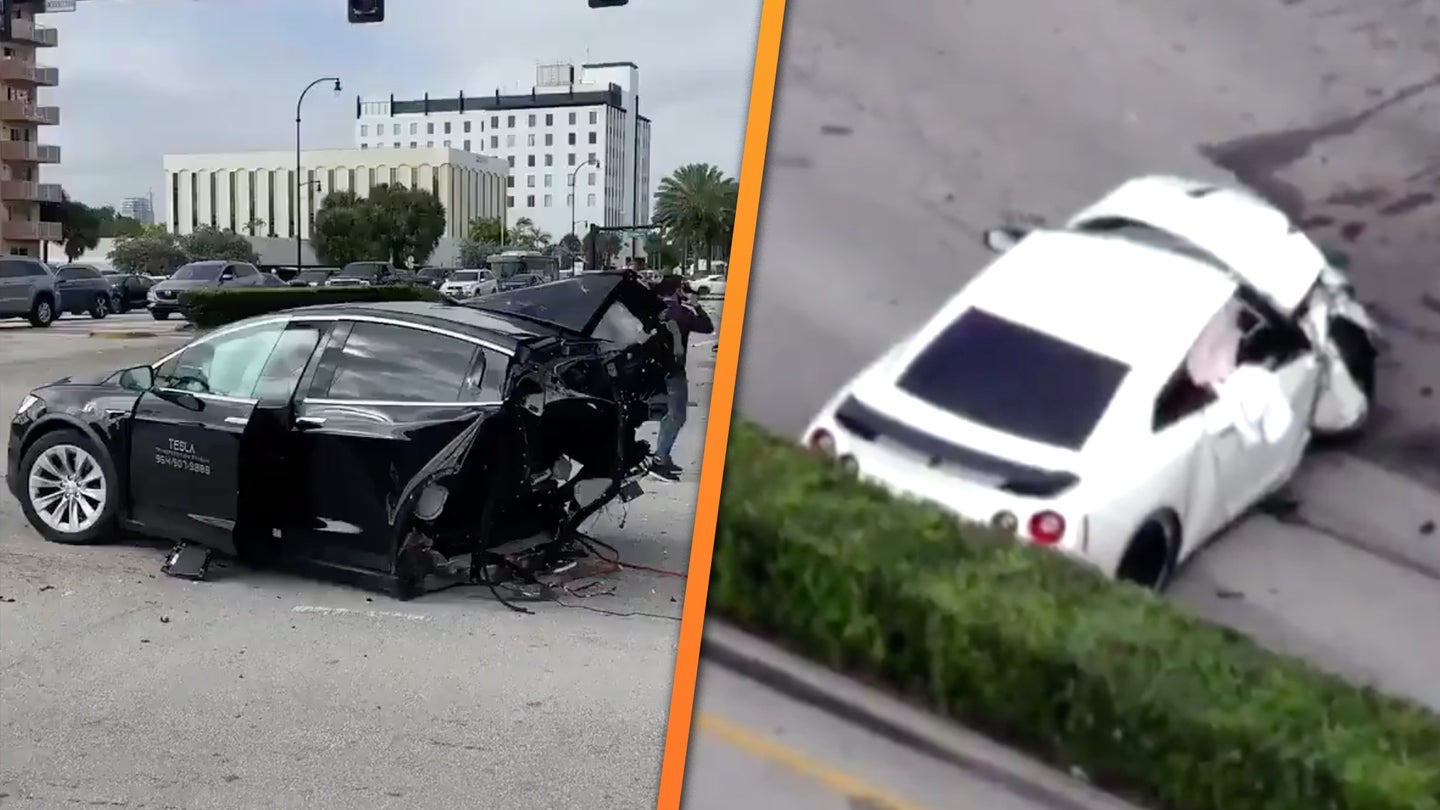Here’s Exactly How a Nissan GT-R Sliced a Tesla Model X in Half
A closer look at the crash that’s captivated the internet.

A high-speed collision in south Florida this week involving a Nissan GT-R and a Tesla Model X ended with the electric SUV dramatically split in half and four people injured. Given the incredible images of the aftermath, we decided to take a closer look at how exactly a modern vehicle can get torn apart in a crash.
According to officials, the white Nissan GT-R sped through a red light at the intersection of Hallandale Beach Boulevard and Three Islands Boulevard before ramming into the rear of the Model X on Monday, reports WSVN. Police confirmed that the GT-R driver would be cited for causing the wreck. Four cars in total were involved, but obviously the Tesla took the hardest hit.

Eyewitnesses backed up the official account of the crash. "That car was flying. It hit the Model X Tesla right in the back,” passerby Ronnie Gnesin told WSVN. “The Tesla flew apart. Next thing you know, the back wheels are flying this way. They hit this car over here."
Another witness described the GT-R driver's reaction. "I went over to help the guy in the white car, because the car had a lot of smoke, and I thought it was going to blow,” Tony Peart said. “He came out unscathed, and he was kissing the floor. It was a little blood coming from his nose, and he said, ‘Oh, I just wanna see my girl.'”
The Tesla driver, named by WSVN as Jose Diaz, was able to walk away from the crash as he only sustained a minor leg injury in the crash. The two occupants of the GT-R were taken to Memorial Regional Hospital for treatment, one with a minor injury and the other with more significant trauma. Diaz told WSVN that the GT-R was driving so fast that he didn't even see him—he only felt the large bang. The detached rear end of Diaz's Model X hit a red Ford Mustang and a black Volkswagen Golf in the crash.
Experts contacted by The Drive explained that this sort of breakaway design is intentional in newer vehicles to protect the passenger cabin.
Sandy Munro serves as the CEO of Munro & Associates, a firm which dismantles and analyzes the parts of new vehicles to understand how they're built. He wouldn't comment on the specifics of this incident without knowing what he called the "crash strategy"—exact speeds, orientation of impact, etc—but he offered general insight on how these sorts of extreme crashes can tear a car asunder. "Cars are made to come apart to protect people," Munro said.
Modern cars are designed to protect the occupants inside by sacrificing the parts around it. We call these crumple zones when we're talking about rear-end or head-on collisions. When something very fast hits something moving at slow speed, there's a lot of energy transferred to the slower car. A piece or chassis section designed to collapse to absorb that energy can simply split off when hit at the right speed and angle, occasionally taking an axle (and in the Tesla's case, its rear drive unit as well) along with it.
The Drive also reached out to the Insurance Institute for Highway Safety (IIHS), which you may recognize from the countless hours of crash test footage they make available online. The IIHS tests cars to see exactly how well automotive safety features work, and more importantly, how the occupants of those cars will fare in a collision.
Like Munro, IIHS Media Director Joseph Young couldn't speak to the specifics of this crash based on the information presented online. The IIHS hasn't evaluated the Model X yet, and the side crash tests they run are only at 31 mph—not exactly "flying," as witness Ronnie Gniesen described the Nissan GT-R's velocity. However, Young noted to The Drive that the GT-R's high speed certainly made the damage to the Model X exponentially worse.
"Excessive speed not only increases the chance of a crash occurring, but also exponentially increases the crash energy that a vehicle must manage," Young said. "For example, when impact speed increases from 40 to 60 mph (a 50 percent increase), the energy that needs to be managed increases by 125 percent.
With that steep increase in energy a car has to manage, a crumple zone managing that energy by shearing off the vehicle makes sense. It helps that the angle of impact was exactly right to avoid compromising the cabin or the Tesla's underfloor battery. Young also pointed to IIHS research that higher-power vehicles like the 565 hp Nissan GT-R are more likely to speed.
The Drive reached out to a Tesla representative to confirm that the rear of the Model X is a zone of the vehicle designed to absorb energy in a collision, but have not heard back at the time of publication. We will update this story if we receive a response.
Safety has always been a major selling point for Tesla's vehicles, with the automaker boasting about its vehicles' 5-star safety ratings with claims that they exceed the National Highway Traffic Safety Administration's (NHTSA) crash test standards. The Tesla Model X, in particular, was designed to be especially hard to roll over. One Model X driver claimed that the vehicle saved his life in another t-bone crash.
h/t: Teslarati
Got a tip? Send us a note: tips@thedrive.com
